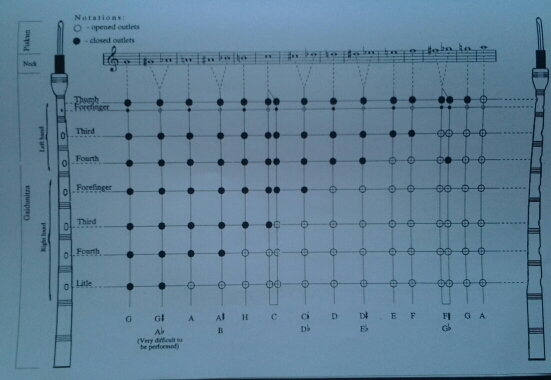First I want to apologise to all the non-pipers who maybe don't understand a word of the following text.
Compared to the Scotish highland bagpipe, the Bulgarian Jura gaida differs in many ways. Apart from the Jura gaida, there is an other type, the Kaba gaida, that I am not playing right now. First of all, the Jura gaida needs much less air and much less pressure than the scotish one. It also has a bigger bag. To keep the sound going you don't have to blow constantly. A full bag gives you an extreme of 20 seconds of playing. To a skilled player, this gives the possibility to sing or talk to the listeners, or when playing only on the upper hand, drink some rakia without stopping to play. A change in pressure can result in altering the sound by half a note. This possibility is widely used among professionals.

A second big difference is the temper(ature) of the sound. The Jura gaida is tempered at 440Hz and therefore fit for classical orchestra playing. In adition to this, it is possible to play half notes, so its possible to play moll and dur, and to transport almost every song into the reach of the pipe. That is, if the Song fits the scale, that reaches on the middle gaiduniza (chanter) from low G to high A like on the Scotish pipe. There are two more gaidunizas, that increase the usability of the gaida when playing with an orchestra. Professionals sometimes change every other song. Because of the different possibilities, the fingering differs a lot. The lower hand is straight forward. Open and close holes to change notes. One may close the low G hole for stability, when playing the upper hand. The upper hand differs a lot. The scotish g-grace is the triller hole in Jura. This is only a small hole and is being used to alter by half notes and also to do the triller ornaments. However it is not being used for the also existing doublings. The exact fingering you can see on the table below. The most used difficulty is the change from F to Fis and back, sometimes from part to part of a tune.
The ornaments have some similarities, but often differ a lot. There are probably names for them in Bulgarian, but in lack of them and the understanding internationally, I have tried to figure out names for them, based on Scotish naming. The most difficult part is to figure out what ornament is to be played where. Basicly all the ornaments start on the beat. Some exeptions existing though. The Bulgarian music knows three signs for Ornaments: Vorschlag , ornaments with triller and "other" the separation of notes is not written but just given as natural. The easiest is the Vorschlag, that is exactly written the way it is played. Doublings (other) differ if they are played upscale or downscale or same note. Upscale is easy: melody note, followed by a strike one note lower. On the upper hand the strike note is never the triller hole, but the next possible hole below. Downscale and samenote: E grace, melody, strike one note lower. In cases the E is not possible, the high g is used. Triller doublings (triller) generally follow the rule: strike one lower, melody, triller. Throws are in use on at least D and E, probably on more notes. They work the same, though the strike is on low A. An ornament on a connection bow is stating, that the ornament is played on the second note, the first note being shortened to ornament note. Eg doubling: D-E-D-F-D_melody.

A connection bow between two different notes indicate a slur. Meaning to open or close the holes carefully, to make the change blurry. Or slurry in this case. In some regions of Bulgaria, songs are practically only consisting of Slurs. They even slur the ornaments, what means that you are not fully opening or closing the ornament holes.
First conclusion after three weeks of playing: This instrument and its music are far more complex than I would have ever thought. The most difficult thing for me is to accept, that there are no written rules about what to play where and how. Everything depends on the taste of the masters. And finally of your own taste.
